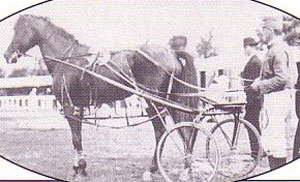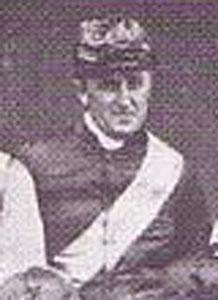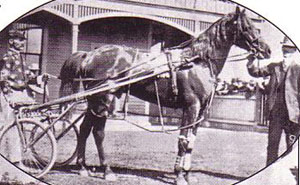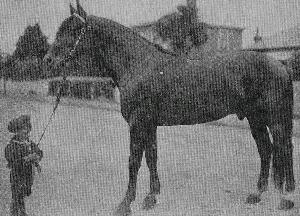| FEATURE RACE COMMENT |
YEAR: 1912
 |
| Albert H & A Hendriksen |
The influence of Rothschild in the early part of the century was never more evident than in the outcome of the 1912 New Zealand Cup, an in the composition of the field that went to the post.
The first three placed horses - Albert H, Ravenschild and Glendolough - were all by Rothschild. this outstanding achievement was later equalled by Light Brigade in 1957, when his progeny - Lookaway, Thunder and La Mignon - were the first three past the post. With the exception of Quincey, who was by Vancleve, all the other 15 acceptors in 1912 were descendants of either Rothschild or Prince Imperial. The latter had four representatives, while Rothschild had seven of his own, three by his sons and one by a grandson.
Albert H, a seven-year-old bay horse, was Rothschild's second New Zealand Cup winner, the first being Belmont M, in 1906. Driven a patient race by his trainer Albert Hendriksen, having his first Cup experience, Albert H came with a determined run in the final stages to win going away by two lengths. Ravenschild (Free Holmes)took second, with four lengths to Glendalough. Albert H paced the two miles in 4:48.8. Emmeline stood alone at the back on handicap, with her nearest rivals, St Swithin and Aberfeldy, five seconds away. The front-runners Medallion, Manderene, Ravenschild and Piecework started from nine seconds. Albert H was one of seven who started from eight seconds.
Albert H was the season's leading money-winner with £881. He was started only twice in the 1911-12 season - at the Canterbury Park meeting the previous June - and had won on both occasions in heavy ground. In August of the current season he was second in the King George Handicap, and the same afternoon won the International Handicap, over a mile-and-a-quarter. Despite this form he started seventh favourite in the Cup.
His dam, Jessie M, was by a thoroughbred horse, Son Of A Gun, who had placed second in the 1888 New Zealand Galloping Cup. Originally 18 horses had been accepted for the 1912 Cup, but Silver Princess and Lady Clare were withdrawn. Altogether 128 runners were accepted for the first day's racing, providing eight capacity fields.
St Swithin was made Cup favourite, Auckland pacer Manderene was second Choice, and Redchild, a trotter, was the next-best supported. However, all three failed to pay a dividend. The start was a shambles. Harry McNae's Gold Bell broke and collided with St Swithin, who dislodged his driver, Andy Pringle. Manderene also broke badly at the start. Bright stumbled after half-a-mile and was pulled up, and Medallion became another casualtywhen he broke and was pulled up near the mile post. So, again, the race was not a good one, with many horses not performing up to their handicaps, and the field was well spread over most of journey.
Showers on the second day made the track heavy. in the main race Adonis (Free Holmes), by Harold Dillon from Thelma, thereby a half-brother to Wildwood Junior, beat Sparkling Kola and Quincey. One of the two trotters who had contested the Cup, Quincey improved on his run when he beat the pacers on the third day, in the Courtenay Handicap. The Vancleve stallion ran an excellent 4:38, 10 seconds faster than the Cup time of Albert H. Master Raymond won the Dominion from Muricata and Kelso, taking 4:52.2 to trot the two miles.
The early indications were that the 1912 meeting would be a successful one, and so it proved. Totalisator returns on Cup Day smashed all records. Betting reached £32,969, with £7053 invested on the Cup. The turnover for the three days was £99,177, well within reach of the club's next milestone, £100,000.
Two alterations greeted patrons when they arrived at Addington for this meeting. The club had put up a large board, visible from all parts of the ground, on which were the names of the riders or drivers. Because of the growing importance of vehicular traffic, the club had bought more land and built a special roadway and entrance for all vehicles.
Harry Nicoll was the top owner for the third consecutive season with £987, well down on the £1547 and £1222 he had won in the previous two seasons.
Credit: Bernie Wood writing in The Cup
YEAR: 1954
 |
The death occurred in Christchurch on Friday of Mr Albert Hendriksen, who about 40 years ago was one of the leading drivers in NZ.
Mr Hendriksen came into prominence when he brought Albert H (which was named after him) from Blenheim for Mr M Mahar just before the 1912 NZ Cup, which he won. Mr Hendriksen then settled in Canterbury, and he drove many winners, including a number for the late Mr W J Morland.
His winners included Country Belle (NZ Cup), Cardinal Logan, winner of many races and second to Kohara in the Cup, Prince Akwood and Peter Mac (NZ Derby Stakes), Erin's King (National Cup), Sungod (Timaru Cup), Hal Junior (Canterbury Handicap), President Wilson and Nantwitch (Great Northern Derby Stakes), and Hustler (Gore Cup).
Mr Hendriksen was for a time studmaster at Santa Rosa Stud, Halswell, when Truman Direct and Real Guy were there.
Credit: NZ Trotting Calendar 9Jun54
YEAR: 1913
 |
| Ravenschild & trainer-driver Newton Price |
The three-day meeting, scheduled for November 11,13 and 14, 1913, was initially in jeopardy. The club held a special committee meeting on November 5 to consider a postponement because of the national waterside strike that had gripped the country. However, the club decided to keep faith with all the horsemen who had already made the long trip to Addington, and proceeded with the meeting. As it transpired, the strike did not prevent any horse from competing, or, apparently, any person from attending.
Ravenschild won the race in hollow fashion from the Australian pacer Denver Huon, with Calm, the race favourite and unbeaten in three starts, a fair third.
The winner, who had been runner-up the year before, gave his sire Rothschild his third Cup success. Such was the large stake offered that Ravenschild was the season's leading earner with £1130, all but £30 coming from his Cup win. The stake for the 1913 New Zealand Cup reached 2000 sovereigns for the first time, the qualifying time was tightened to 4:38, and for the first time a prize for fourth place was offered. Ravenschild's share of the stake was 1100 sovereigns, Denver Huon 400, Calm 300 and Manderene 200. Total stakes offered by the club over the three days were 8000 sovereigns. The Canterbury Jockey Club, which had been in existence more than 50 years, also had a 2000 sovereign stake for it's traditional November New Zealand Galloping Cup. The Metropolitan Club, in just nine years, had raised the stake of it's prestigious race from 310 socereigns to the equal of its more illustrious provincial companion.
Totalisator turnover on Cup Day was a record £42,558, and the Cup betting of £7257 10s was also a record. For the first time the turnover eclipsed the Canterbury Jockey Club's betting on its Cup Day, held as usual three days before the Trotting Cup. The three-day Addington turnover reached a record £124,362, up £25,185 on the previous year.
The club received 23 nominations for the Cup, and only Bell Metal and Princess Louise were withdrawn, which left an over-capacity field. Twelve horses started from the front line of six seconds and from that mark Ravenschild was quickly into the lead for Newton Price. Passing the stands for the first time, Lord Dillon headed Ravenschild, who was followed by Manderene, Little Tib, Aberfeldy, Stop It and Calm. Well rated by his trainer-driver, Ravenschild regained the lead shortly after and by the time the straight was reached was going too well for the others. He finally won by eight lengths in 4:35.6.
Denver Huon, the Australian champion from Sydney, came to the meeting with a reputation for exceptional speed, and from his handicap of two seconds ran a fine race. He had to make his way through the big field, and was timed at 4:33.4. Denver Huon was under the care of Manny Edwards, who had migrated to New South Wales and set up a stud farm and training establishment. Edwards' horses arrived by sea via Melbourne, Hobart and Bluff. The trip was a rough one and Denver Huon, in particular, lost condition. As a result he had worked poorly before a good final trial on the Sunday before the Cup, which convinced his connections to continue with the race.
As expected with such a big, unwieldy field, the start was unsatisfactory. The horss paraded past the stands and then walked to the starting point. They began racing some lengths before reaching the post, getting off in straggling order. Again, Andy Pringle bore the brunt of the disorder and was tipped from the sulky of Glendalough. King Cole, Medallion and Gold Bell broke hopelessly and took no part in the contest.
The Wildwood Junior-Gertie six-year-old Calm, who started from the front, lost his unbeaten record after a slow start. Passing the stands the first time, Bill Kerr's pacer was six seconds behind the leading division. He gradually moved up and, starting the last lap, had moved into third place. Calm chased Ravenschild into the straight and broke, allowing Denver Huon to pass him.
King Cole (out of retirement) had broken Ribbonwood's mile record in 1911, registering 2:08.6. He shared the scratch mark with his co-Australasian mile record-holder Emmeline, who recorded her mile time in the 1912-13 season.
Andy Pringle gained some compensation for his bad luck in the Cup when he rode and drove three winners - Win Soon, Country Belle and Gianella - on the second day. Albert H returned to form, winning the Canterbury Handicap from Red Mac and the trotter Muricata. His winning time of 4:33 equalled the New Zealand record set by Wildwood Junior in 1910.
The third day blonged to the four-year-old trotter Michael Galindo, from the Cliff Tasker stable. After an early break, he made up ground in grand styleand won the Dominion Handicap from Muricata and Quincey.
The most significant newcomer amongst the trainer-drivers at the meeting was James "Scotty" Bryce. The litle man had landed in Wellington from Scotland with his wife and five children earlier in the year. His rise to fame and fortune was repid. Both his sons - James Junior and Andrew - followed him into harness racing and thr Bryce family won every honout there was to achieve in the sport. Scotty Bryce won the national premiership for trainers eight times and he headed the driver's premiership five times. Despite his poor debut with King Cole in 1913, the big races in later years - the New Zealand and Auckland Cups - were easy prey.
Bryce family members were associated with six New Zealand Cup and 11 Auckland Cup victories. Only the Holmes family, Free and his three sons - F.G., Allan and Maurice - who between them won the New Zealand Cup seven times, can boast a better family achievement at Addington. (F.G. was always known by his initials because his first name was the sae as that of his father).
Cecil Devine equalled Scotty Bryce's six New Zealand Cup training successes when Lord Module annihilated the 1979 field. Later still, Roy Purdon, with his two sons, Barry and Mark, produced their sixth victory between them in 1996 when the brilliant Il Vicolo won his second New Zealand Cup.
Credit: Bernie Wood writing in The Cup
YEAR: 1889
 |
Though some may find it hard to concede with the present ever growing list of super sires, there is a strong case for suggesting that the greatest sire that ever stood in NZ is not Light Brigade, U Scott, Jack Potts, Dillon Hall or even Logan Pointer.
Rothschild, now a name that is only come across well back in modern pedigrees has as good a claim as any when it comes to rating sires in order of merit. For one thing he sired over 300 winners. That's a cracking total today but at the turn of the century it was a sensational achievement, difficult to appreciate now. There were fewer meetings then and so fewer races.There were fewer finely bred mares and it took some time for Rothschild to attract the ones that were available. What is more, Rothschild had to do everything on his own achievements. His name appears only once in the list of winning sires, in 1915-16 the first year records were officially kept. But no one doubts that he was the leading sire for many years before that, and had the records been kept he would have more premierships than anyone.
Bred in Australia in 1889, Rothschild was by Childe Harold, an expensive, but somewhat disappointing sire who has Harold Park named after him. Rothschild's dam Belle Briggs was considered to be the best bred mare to come into Australia to that time and but for being unsound it is doubtful that she would ever have left America. Rothschild had a brother called Osterley who was a top rachorse across the Tasman, only Fritz being able to beat him. Dan O'Brien, that most colourful figure of the turf, recommended to NZ friends that they buy Osterley, but they were unable to do so so bought his younger brother instead. It was just as well, for Osterley was a major disappointment at the stud.
Rothschild started in a number of races but never won, and as late as 1902, when 13 years old he was still making the odd appearance, though most owners would have given up by then. He stood at Mr W Jarden's Stud in Gloucester St, Christchurch and his breeding enabled him to command a five guinea fee. The bright bay stallion did not take long to make an impression. From his first crop came a sensational juvenile trotter Jessie Palm who streeted her opponents at two starts at two and went on to become a champion trotter. From his first crop too came The Baron who was a top performer in the last days of the Lancaster Park track in Christchurch.
The following year he produced Almont who was the sensation of his day. When he retired Almont took with him a three mile record of 6:50 which was actually never beaten. When he started his career the record was fully two minutes slower. Sal Tasker was another fine Rothschild mare going 2:20 for a mile at two years of age away back in 1906. She eventually went 2:12 and was the champion of her time. So was Emmeline a NZ mile record holder at 2:08.6 and placed in the NZ Cup. About the same time was the trotter Revenue, holder of the mile trotting record for 22 years with a time of 2:11.8 recorded at Forbury in the saddle. He often took on and beat fields of pacers.
Dan Patch, bred in Ashburton, but perhaps better known in Australia than his homeland, was another fine son of Rothschild. A free-legged pacer, Dan Patch held the Australian mile record of 2:10 for many years and in NZ he went a mile in 2:09.4 on Auckland's grass track. A genuine champion Dan Patch unfortunately died before starting a stud career of any significance.
Rothschild sired three NZ Cup winners. Belmont M upset winner of the 1906 Cup was the first, Albert H in 1912 the second and Ravenschild, second to Albert H the previous year, won easily in 1913. In the 1912 Cup in fact Rothschild horses filled the first three places while other sons and daughters to fill places were Evelyn, Lord Elmo, Moneymaker and Bright.
Harold Rothschild, later a very successful sire was another of Rothschild's offspring to do well and other sons who were fine racherses and sires were Gold Bell (one of the finest pacers the North Island ever saw), St Swithin and Jingle. Master Raymond was an outstanding trotter by Rothschild winning eight times over two miles. Pearlchild, Aileen, Capitalist, Lord Chancellor, Lady Sybil, Emilius and Coin were other very successful racehorses.
If he was a great sire himself Rothschild gained even greater fame through his daughters. Many of his most successful matrons were themselves good on the track and easily the best known was Pearlchild. Winner of many races for Mr H F Nicoll, including the National Handicap, Pearlchild, a daughter of Verity, produced ten individual winners at stud. Among them were three Derby winners (Ciro, Childe Pointer and Nantwich) a successful sire (Casanova), First Wrack, winner of 11 races and outstanding mares Vanity Fair, Pearl Pointer and Double Measure. The great record of the Verity family owes much to Pearlchild. Vanity Fair in particularly was an outstanding broodmare herself.
Another Rothschild mare now well known was Moonbeam, the grandam of Horotane and therefore ancestress of current Broodmare of the Year in Nancy Lee. Henrietta produced Haymetta, the winner of five and in turn dam of Duncraig who won nine. Jessie Fraser produced the successful racehorse and sire Logan Fraser. Cocaleen was the dam of four winners including the earlier mentioned top pacer Moneymaker and Logaleen who won five.
An unnamed Rothschild mare produced Golden Square the dam in turn of Graticulate who won eight. Sweet Daphne was a most successful mare being the founder of the family best known in recent years though the deeds of horses like Bright Highland and Bright Enterprise. Bright Alice, another daughter of Rothschild produced Cup winner Kohara who later did well at stud, and the Rothschild mare Kola Nut produced King Cole the mile recordholder of his day and a very successful sire. It was from King Cole's matings with Norice which has produced one of the greatest breeding lines in the Stud Book, a line commonly associated with veteran breeder Ben Grice.
A mare by Rothschild was the dam of Yenot who gained fame through the deeds of Parisienne and later La Mignon, Garcon Roux etc. Another Rothschild mare was the ancestress of Van Dieman and yet another unnamed mare the founder of the family to which Vanadium and Van Glory belong. Sal Tasker produced Coldstream Bells, a successful sire in the first quarter of the century. Another great Rothschild mare was Ocean Wave, dam of Muricata who produced two champion pacers in Ahuriri (two NZ Cups) and Taraire and who is the fourth dam of the trotting sire Great Evander.
Auckland Girl, who won eight races herself, was another successful mare at stud as was Dollar Princess who produced seven individual winners. Among them was Doraldina, winner of the Sapling Stakes and Derby and who herself produced five winners. Recess, grandam of Aldora was a member of the same family as was Gold Chief a Derby winner and sire of the champion Rupee. Another Rothschild mare Lady Derby founded one of the best branches of the Norice family which includes Maudeen, Queen Maude and Indecision among it's members. A mare by Rothschild founded the Gentle Annie family which claims among others the champion trotter Moon Boy and top pacer of yesteryear in Betty Boop. Then there was Olive Child, dam of Audubon Child, who in a colourful career won eight races.
The full relations Emmeline, Emilius, Aileen and Evelyn did great work for Rothschild's reputation and they may have set a record when three of them appeared in the same NZ Cup field and two were placed. Aileen produced at stud the Cup class pacer Ronald Logan and Emmilene founded a successful family, one prominent recent member being Cuddle Doon. Evelyn won five races herself and was the dam of four winners. Emilius had some success as a sire.
Altogether Rothschild daughters produced over 300 individual winners. Rothschild had much more success than many imported sires as far as his sons were concerned and a number of them are well known stud names. Harold Rothschild did very well down south and as a son of one of Southland's most successful foundation mares in Harold's Rest he played a prominent part in two other big Southland families, particularly in that of First Water whom he sired.
Capitalist sired the fine racehorse and good sire in Gold Bell. Lord Elmo sired some good mares in particular and so did Almont. George M Patchen appears in the pedigree of Cardigan Bay and Globe Bay and another son St Swithin sired the dam of Springfield Globe. Woodchild, Lord Chancellor, Imperial Crown, Proudchild, Prosphorous, St Kevin (a brother to Dan Patch) and Pygmalion, were other Rothschild horses to make an impression at stud while his Cup winner Ravenschild did well also.
Rothschild spent his declining years in the unlikely location of the Wellington Zoo and he died there in the early 20s at the age of 32. Shortly before his death his stock held the Australian and NZ mile pacing records, the Australasian trotting mile record and the world record over three miles. Though he officially topped the sires list once he remained in the top five for many years, even into the 1920s which shows the hardiness of his stock. Indeed his last representative on the tracks was still going in 1929. At one stage in his hey day just before World War I the sons and daughters of Rothschild held every official record in Australasia, a feat few can equal.
He was a horse of quite remarkable disposition and an existing photo of him shows him being confidently led by a lad not five years old. I wonder how many of our much boomed later sires could have fashioned a record equal to Rothschild if serving the class of mare which dominated his court. It might be worth noting that during his stud career Rothschild, in NZ alone sired more winners than the great Globe Derby managed across the Tasman. He was a remarkable influence in the development of the standardbred as we know it, and it would be a brave man who could state with certainty that any of his successors was a greater sire.
Credit: David McCarthy writing in NZ Trotguide 23Mar77